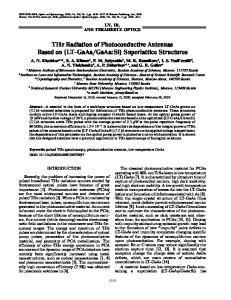Superconducting Superlattice Structures
- PDF / 474,617 Bytes
- 7 Pages / 420.48 x 639 pts Page_size
- 11 Downloads / 376 Views
SUPERCONDUCTING SUPERLATTICE STRUCTURES JOHN L. MAKOUS,* JOHN A. LEAVITT,* LAURENCE C. McINTYRE,Jr.,* LUIGI MARITATO,** RUGGERO VAGLIO,*** ANNAMARIA CUCOLO***, and CHARLES M. FALCO* *Department of Physics and Optical Sciences Center, University of Arizona, Tucson, Arizona 85721 **INFN-LNF, Via E. Fermi 40, 00044 Frascati, Italy ***Dipartimento di Fisica, Universith di Salerno, 84100 Salerno, Italy
ABSTRACT Superlattice superconductors exhibit behavior different from other "homogeneous" superconductors because of their layered structures. Sputtering has proved to be an excellent technique for producing such multilayered systems. Also, systems naturally having layered structures, such as the new high-Ta materials, can be fabricated by sputtering. Here we describe the preparation of superconducting superlattices by dc triode sputtering and techniques useful for characterizing them. In particular, we discuss Mo/Ta superconducting superlattices and high Tc thin films of YBa2Cu3O7-x.
INTRODUCTION The properties of elemental superconductors are insensitive to nonmagnetic impurities and to microstructural defects. This is as predicted by the BCS theory. However, because the coherence length in many superconductors is long, typically of order 50 A to I ,xa,it is possible to affect the properties of a superconducting film by the proximity effect with a normal metal, or by forming superlattices. These metallic superlattices are fabricated by alternately layering thin layers 2 A to 5000 A of a superconductor with another material, which may or may not be a superconductor. The superconducting properties of these systems then become structure dependent, as exhibited, for instance, by dimensional crossovers [1,21, proximity effects on the Tc's and the energy gaps [3,4], and by anisotropies in the critical field [5]. The "new" high Tc superconductors by comparison are very structure dependent, both in the bulk and as thin films. They also exhibit critical current and critical field anisotropies, which might be expected from their naturally layered or "superlattice" structure. Sputtering techniques have been shown to be very useful for producing metallic superlattices [6]. In addition, sputtering of metallic superlattices of Y, Ba, and Cu in various layer combinations recently has been successfully used as a method for producing thin films of the high Tc oxide materials [7]. In this paper we briefly describe the preparation of superlattices by sputtering as well as techniques used to characterize their structure. These techniques include several x-ray analysis methods and Rutherford backscattering spectroscopy (RBS). Specifically we discuss the preparation and characterization of Mo/Ta superlattices and of high Tc thin films of YBa2Cu3O7-x. Physical properties of these Mo/Ta superconductors will be described, including the resistivity and layer thickness dependence of Tc, and tunneling results. Finally, we include a discussion of the structure and resistive transitions of the high-To YBa2Cu3Ol-x films prepared by the sputtering o
Data Loading...









